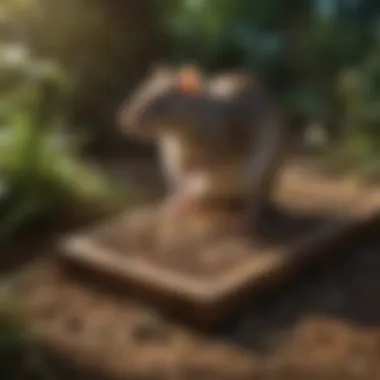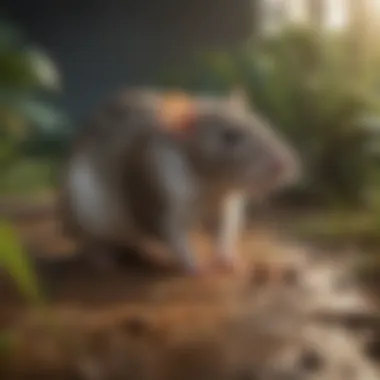Understanding Good Nature Rat Traps: Eco-Friendly Solutions


Intro
Pest control is an essential aspect of maintaining a healthy and safe living environment. Among common pests, rats are often the most troubling. They can cause significant damage to property and pose health risks due to the diseases they carry. In our pursuit of effective solutions, it is vital to consider ethical and environmentally friendly methods. Good nature rat traps emerge as a compelling choice, combining effectiveness with a commitment to humane pest control.
In this guide, we aim to provide a clear understanding of good nature rat traps, how they function, and their role in sustainable pest management. By exploring relevant strategies and tips, homeowners can effectively address rat issues while minimizing ecological impact.
Understanding the Pest
Identification
To implement an effective pest control strategy, first, it’s essential to identify the specific pest. Rats come in various species, with the most common found in homes being the Norway rat and the roof rat. Norway rats are stout, with brown fur and a blunt snout. They usually dwell in basements, sewers, and ground floors. Roof rats, on the other hand, are smaller, identifiable by their sleek black fur and pointed snouts, typically nesting in attics and upper structural parts of a building. Knowing which species is present can guide the selection of appropriate traps.
Life Cycle
Understanding the lifecycle of rats adds another layer of insight. Female rats reproduce quickly, capable of producing up to eight litters a year, each containing 6 to 12 pups. The gestation period is about three weeks. When these pups are born, they mature rapidly, often reaching reproductive age in just a few months. This fast life cycle means that an infestation can escalate swiftly if not addressed.
Pest Prevention Strategies
Environment Modification
One of the most effective ways to minimize rat presence is through environmental modification. Simple steps can deter rats from making your home their nest:
- Remove Food Sources: Store food in sealed containers. Ensure garbage bins are tightly closed.
- Eliminate Shelter: Clear clutter in and around your home. Rats seek hiding spots.
- Seal Entry Points: Inspect your house for cracks or holes and seal them to prevent entry.
Physical Barriers
In addition to modifying the environment, physical barriers can help block rat access. Using heavy gauge wire mesh to seal vents and holes can be effective. Installing door sweeps and maintaining effective drainage systems prevents rats from finding entrances within your home.
Control Methods
Chemical Control
While good nature rat traps focus on humane control, some homeowners may consider chemical options. Rodenticides pose risks not only to rats but to pets and children. Therefore, it’s crucial to use them judiciously and follow all safety guidelines.
Biological Control
Biological control involves using natural predators or diseases to manage rodent populations. However, this approach can be difficult to implement in residential areas and is not commonly practiced for rats in urban settings.
Prelude to Good Nature Rat Traps
Understanding how Good Nature Rat Traps function is essential for homeowners looking for a pest control method that balances efficacy with environmental responsibility. This section aims to highlight the key features of these traps while also discussing their benefits and considerations. By examining how these eco-friendly traps work, we can appreciate their role in sustainable pest management strategies.
Overview of Good Nature Products
Good Nature offers a range of innovative products designed specifically for humane pest control. Their rat traps are engineered to effectively capture rats without causing them harm. These traps utilize advanced mechanics to ensure a high success rate, making them a reliable choice for homeowners dealing with rodent issues. Notable products include the A24 and the A18 rat traps, which can be used both indoors and outdoors. They are constructed to avoid accidental triggering and are simple to set up, which is an attractive feature for those new to pest control.
The traps are designed with user-friendly aspects in mind, ensuring that individuals can confidently use them without professional assistance. Furthermore, the mechanisms in these products are created with sustainability in mind, reducing the overall environmental impact of pest control practices.
Importance of Eco-Friendly Traps
The significance of employing eco-friendly traps cannot be overstated in today’s ecological landscape. Traditional traps often contribute to environmental degradation and can cause unintended harm to non-target species. By opting for products like Good Nature traps, users engage in a more responsible method of pest control that aligns with growing environmental awareness.


Using eco-friendly traps fosters a balance between human needs and wildlife preservation. These traps are crafted to minimize harm to other animals, thus supporting biodiversity.
Moreover, relying on humane traps reflects a shift in understanding pest management. It challenges outdated views where killing pests was deemed acceptable without consideration for ecological impacts. Employing Good Nature Rat Traps shows a commitment to ethical practices while effectively managing rodent populations. This approach benefits both homeowners and contributes positively to the ecosystem at large.
Design Features of Good Nature Rat Traps
In evaluating eco-friendly pest control, the design features of Good Nature rat traps hold crucial significance. These elements not only enhance usability, but also promote humane approaches to handling rodent issues. Effectively designed traps can contribute to better results, minimizing harm to both the target species and the surrounding environment.
Mechanics of the Trap
Good Nature rat traps employ a unique mechanical system. This mechanism typically uses a two-way entry, allowing rats to enter from either side. Once the rat is inside, a spring-loaded action promptly and humanely dispatches the rodent. This method is designed to minimize suffering, aligning with the principles of humane pest control.
Another significant aspect is the trigger sensitivity. The traps are designed with a refined sensitivity that ensures only rats are captured. This reduces the likelihood of capturing non-target animals, which is an essential factor in maintaining biodiversity. Furthermore, these traps do not rely on poison, which can pose hazards to pets, wildlife, and even children.
Material Considerations
The choice of materials used in constructing Good Nature rat traps is vital for their effectiveness and sustainability. High-quality, durable materials are selected to withstand various environmental conditions. This ensures not only longevity but also reliability in performance. Often, these traps use recyclable materials, emphasizing their eco-friendly nature.
Moreover, the finishes on the traps are designed to be resistant to weather conditions. This minimizes degradation, meaning that the trap can operate effectively over extended periods without losing functionality. The materials chosen are also easy to clean, promoting sanitation for homeowners.
User-Friendly Aspects
Good Nature rat traps are designed with user experience in mind. The setup process is straightforward, allowing homeowners to install the traps without needing expert guidance. Clear instructions accompany the product, which simplifies the initial setup.
Additionally, the design often includes visible indicators to show when a trap has been activated. This feature enables users to monitor the traps without needing to disturb them frequently, which is beneficial for both effectiveness and peace of mind.
To facilitate maintenance, these traps are designed for easy cleaning. A quick rinse or wipe can remove debris or dirt, which maintains hygiene and enhances the trap’s longevity.
"The design of a trap directly influences its efficacy, user satisfaction, and environmental impact."
In summary, the design features of Good Nature rat traps play a pivotal role, especially in the context of humane and eco-friendly pest control. From the mechanics ensuring swift action to the choice of sustainable materials, every aspect has been carefully considered to create a product that is not only effective but also responsible. These elements make Good Nature rat traps an attractive option for homeowners looking for humane solutions.
Efficacy of Good Nature Rat Traps
Efficacy is a critical factor when evaluating pest control solutions, especially among homeowners seeking effective and humane options. Good Nature rat traps stand out because they combine efficiency with a focus on environmental responsibility. Understanding their efficacy can guide users in making informed choices, ensuring that they address rat infestations effectively without compromising their values.
Comparison with Traditional Traps
Traditional traps, including snap traps and glue traps, often rely on lethality to control rodent populations. While they may seem effective, they have significant drawbacks. For one, snap traps can pose a threat to pets and children. Moreover, they may cause prolonged suffering to the animals, raising ethical concerns.
In contrast, Good Nature rat traps are engineered with humane treatment at their core. They utilize a method designed to quickly and painlessly neutralize target species. This approach not only alleviates the ethical dilemmas associated with traditional traps but also enhances the overall effectiveness in managing a rat population.
- Safety: Good Nature traps reduce risks to non-target species, making them a safer choice for families and pets.
- Reliability: These traps use a unique mechanism that ensures quick action, reducing the chances of missed opportunities when catching pests.
- Ease of Use: Their user-friendly design makes it simple to set up, which can enhance the effectiveness of the pest control strategy.
Success Rate Analysis
The success rate of Good Nature rat traps is supported by several factors that affirm their superiority over alternatives. Field tests and user reports indicate that these traps yield high capture rates while promoting humane practices. For instance, users have noted a significantly lower rate of escape compared to traditional traps.
Several key points contribute to their success:
- Baiting System: The traps are compatible with various baits, which maximizes attraction and increases success rates in different environments.
- Durability: Made with robust materials, these traps withstand weather variations, making them suitable for both indoor and outdoor use.
- Continuous Capture Potential: Many models allow for multiple captures without needing manual intervention, streamlining the process.
Humane Pest Control Practices


Humane pest control practices have gained significant importance in recent years. As people become more aware of environmental issues, there is a stronger push towards strategies that reduce harm to animals and their habitats. This article explores how adopting humane methods can be beneficial not just to the critters involved but also to homeowners and the ecosystem at large.
Humaneness in pest control is more than just a moral choice; it reflects a broader understanding of wildlife management. Ethical treatment of animals aligns with the values of sustainability and responsibility. In a world where biodiversity is crucial, humane trapping methods serve to maintain the balance without resorting to inhumane methods.
Definition of Humane Trapping
Humane trapping refers to the use of traps specifically designed to capture pests without causing them pain or suffering. These traps allow for the safe relocation of animals, such as rats, instead of killing them. Humane traps can range from live-capture cages to specific designs that prevent injury. The goal here is to enable a solution that addresses pest issues while respecting the animals involved.
For example, Good Nature rat traps are engineered to efficiently catch rodents without stress. These traps work on a principle that ensures the animal is unharmed, providing a type of pest control that residential users can feel confident in using. Effective humane trapping also involves understanding the behavior of the pests, which enhances the chances of successful captures.
Regulations and Recommendations
As humane trapping evolves, various regulations and recommendations have emerged to guide its implementation. Many countries have established guidelines to ensure that trapped animals are treated in line with ethical standards. Familiarizing oneself with these regulations is critical to remain compliant and to practice responsible pest control.
Most humane trap guidelines focus on:
- Quick and efficient removal of trapped animals.
- Regular check-ups of traps to minimize stress for the captured pests.
- Relocation areas that are acceptable and won't harm the relocated species.
In addition, organizations such as the Humane Society provide valuable resources and recommendations. They emphasize proper education on how to set traps, how to handle captured animals, and best practices for releasing them safely.
"Choosing humane options in pest control not only helps the animals but also contributes to a more sustainable environment."
Set-Up and Usage of Good Nature Rat Traps
The correct set-up and usage of Good Nature rat traps is central to their effectiveness and efficiency in pest management. These traps offer an eco-friendly alternative to traditional methods, but they need to be employed thoughtfully to yield the best results. Understanding optimal placement, baiting techniques, and regular maintenance can significantly enhance the effectiveness of these traps.
Optimal Placement Strategies
Choosing the right location for the traps is crucial. Rats are generally nocturnal and tend to follow specific pathways. Thus, placing traps along walls, in corners, or near signs of rat activity can increase success. Areas such as attics, basements, and near food sources are prime locations for setting traps.
- Look for signs: Droppings, gnaw marks, and nest materials indicate where traps should be placed.
- Height matters: Setting traps closer to the ground aligns with the natural behavior of rats, ensuring better interaction.
- Avoid obstructive elements: Traps placed away from clutter or obstructions increase visibility and accessibility for the rodents.
Baiting Techniques
Effective baiting is another critical component of the trap's success. Bait must be attractive enough to coax the rats into the trap. Good options include peanut butter, dried fruit, or nuts. These baits are not only appealing but also easy to apply. Here are some useful tips for bait placement and handling:
- Use the right amount: Too much bait may cause spillage and reduce effectiveness. A pea-sized amount is generally sufficient.
- Secure the bait: Make sure the bait is fastened well to avoid rats taking it without triggering the trap.
- Change baits regularly: If traps are not attracting rats, change the bait to maintain their interest.
Maintenance and Monitoring
Regular maintenance and monitoring of Good Nature traps are essential for sustained effectiveness. Ensuring traps are clean, functional, and correctly set will improve success rates over time. Consider the following practices:
- Inspect frequently: Regular checks (at least once a week) help to maintain the traps and ensure they are working correctly.
- Clean the traps: Wipe down the traps with a damp cloth to remove any residue that may discourage rats from entering.
- Record observations: Keeping track of catches and placements can provide insights into the most effective strategies moving forward.
"Proper set-up and consistent monitoring are key to achieving successful outcomes with Good Nature rat traps."
Impact on the Ecosystem
The use of Good Nature Rat Traps extends beyond mere pest control; it reflects a deeper commitment to preserving the environment. Understanding the impact on the ecosystem is crucial for any homeowner considering these traps as part of their pest management strategy. The significance of using eco-friendly solutions like these traps lies in their design and function, which prioritize the environment while effectively managing rodent populations. In this section, we will explore the long-term environmental benefits and non-target species considerations associated with these traps.
Long-Term Environmental Benefits


Good Nature Rat Traps are not only designed to manage rat populations, but they also promote sustainable practices. Some of the notable long-term benefits include:
- Reduction of Chemical Use: Traditional pest control methods often rely on harmful chemicals that can leak into the soil and water systems. By using eco-friendly traps, homeowners minimize this risk, contributing to a cleaner environment.
- Wildlife Preservation: These traps are designed to be humane and non-lethal. By avoiding methods that cause unnecessary harm to native species, they help maintain biodiversity in the area.
- Sustainability: Good Nature Rat Traps often utilize materials that are recyclable or made from sustainable resources. This reduces waste and promotes responsible consumption in pest management practices.
- Education and Awareness: By choosing eco-friendly options, consumers naturally become advocates for greener practices. This increased awareness can lead to community discussions on environmental responsibility and sustainable behaviors.
Of these benefits, the reduction in the use of toxic substances is one of the most pressing considerations for homeowners who are concerned about their ecological footprint. As more people transition to using Good Nature Rat Traps, the cumulative effect can lead to significantly healthier ecosystems.
Non-Target Species Considerations
In any pest control strategy, it is essential to consider the potential impact on non-target species. The design of Good Nature Rat Traps addresses this concern effectively. Here are several aspects to consider:
- Targeted Approach: Good Nature Rat Traps focus on capturing specific pests like rats, minimizing the chance of inadvertently trapping other species.
- Field Testing: Many of these traps undergo rigorous testing to evaluate their effects on other wildlife. Studies confirm that they have minimal impact on non-target species.
- Eco-Friendly Design: The materials used are often biodegradable or non-toxic, ensuring that even if a non-target species encounters the trap, there is little chance of harm.
- Local Wildlife Awareness: Using these traps can help promote a better understanding of local ecosystems. Homeowners who are informed about the species in their environment are more likely to adopt responsible practices that protect all creatures.
"The humane design of Good Nature Rat Traps not only aids in effective pest control but also nurtures a balanced ecosystem, making them a preferred choice for conscientious homeowners."
User Experiences and Case Studies
The section on user experiences and case studies is crucial in understanding Good Nature rat traps. Real-world accounts provide evidence of the traps' effectiveness and highlight their impact on pest control. These experiences reveal practical insights that can guide prospective users in making informed decisions. By examining diverse implementations, we can also evaluate the advantages and limitations users encounter, thus providing a balanced view of Good Nature products.
Successful Implementations
Many homeowners have reported positive outcomes when using Good Nature rat traps. These experiences typically emphasize the traps' humane operation and their efficacy in controlling rodent populations. For example, one user noted how the automatic resetting mechanism minimized their need for constant maintenance. The trap successfully caught multiple rats in a short time, showcasing its utility and convenience.
Some advantages cited by users include:
- Ease of Use: Many find the setup and baiting process straightforward, reducing the intimidation often associated with traps.
- Sustainability: Users appreciate the eco-friendly design, which aligns with their values regarding environmental responsibility.
- Reduced Animal Suffering: The humane methodology resonates with a growing number of users who prioritize ethical pest control solutions.
A case study conducted in an urban area illustrated a reduction of rat sightings by over 60% when residents collectively used Good Nature traps. This was a significant improvement, showing not only the traps' effectiveness but also how community involvement can enhance pest control efforts.
Challenges Encountered
While many users have had positive experiences, some also encountered specific challenges. Understanding these issues can help others prepare adequately before implementing the traps in their own homes.
Some common challenges reported by users include:
- Initial Learning Curve: A few users experienced difficulties in understanding the reset mechanism at first, leading to frustration. Proper guidance is essential for effective use.
- Placement Issues: Some users found it challenging to identify the optimal locations for trap placement. Understandably, improper placement can lead to reduced effectiveness.
- Bait Preferences: Different rodents may respond to various types of bait. Finding the right bait that works can take time and experimentation.
In summary, user experiences and case studies shed light on the multifaceted nature of implementing Good Nature rat traps. The successful outcomes highlight their effectiveness, while the challenges provide valuable lessons for prospective users.
Finale
The conclusion of this article serves as an essential synthesis of the key points discussed regarding Good Nature rat traps. Understanding this topic is crucial for homeowners who prioritize eco-friendly pest control solutions. By using these traps, one can minimize environmental impact while efficiently addressing rodent issues. The traps not only focus on eliminating the problem but also emphasize humane methods that ensure the welfare of the animal population.
Summary of Findings
In summary, Good Nature rat traps stand out as a responsible choice for pest management. Important findings include:
- Design and Efficacy: These traps are crafted with advanced mechanisms that ensure a high success rate without harming non-target species.
- Eco-Friendly Practices: Utilizing biodegradable materials and avoiding toxic substances, these traps align with sustainable values.
- User-Friendly Features: Many users appreciate the ease of setup, maintenance, and monitoring, making them accessible for various households.
- Real-Life Case Studies: Evidence from users demonstrates successful implementation in a range of environments, addressing both domestic and commercial rat control.
These elements highlight the significance of integrating Good Nature traps into a comprehensive pest management strategy. They address concerns regarding safety, environmental sustainability, and effectiveness.
Future of Good Nature Traps
Looking ahead, the future of Good Nature traps appears promising. Innovations in design and usability may further enhance their effectiveness. Potential considerations include:
- Continuous Research: Ongoing studies could yield better materials or mechanisms that increase the success rate.
- Broader Acceptance: As awareness of humane pest control grows, more homeowners may choose these eco-friendly options.
- Integration with Technology: Future iterations may incorporate smart technology, allowing users to monitor traps remotely.
"The demand for humane, eco-friendly pest control solutions reflects a significant shift in public awareness about sustainability."
The insight derived from this article can guide consumers in making informed choices regarding pest management. By embracing Good Nature rat traps, homeowners contribute to a more sustainable and humane approach to living alongside nature.







